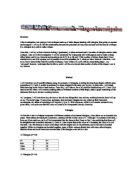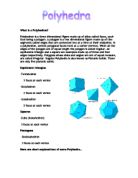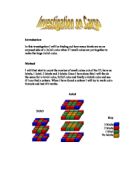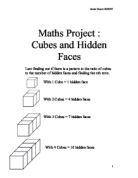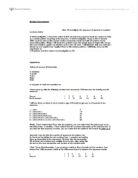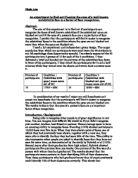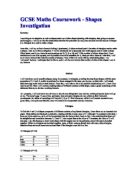GCSE Math Coursework - Shapes Investigation
Summary I this investigation I am going to look at shapes made up of other shapes (starting with triangles, then going on squares and hexagons. I will try to find the relationship between the perimeter (in cm), dots enclosed and the amount of shapes (i.e. triangles etc.) used to make a shape. From this, I will try to find a formula linking P (perimeter), D (dots enclosed) and T (number of triangles used to make a shape). Later on in this investigation T will be substituted for Q (squares) and H (hexagons) used to make a shape. Other letters used in my formulas and equations are X (T, Q or H), and Y (the number of sides a shape has). I have decided not to use S for squares, as it is possible it could be mistaken for 5, when put into a formula. After this, I will try to find a formula that links the number of shapes, P and D that will work with any tessellating shape - my 'universal' formula. I anticipate that for this to work I will have to include that number of sides of the shapes I use in my formula. Method I will first draw out all possible shapes using, for example, 16 triangles, avoiding drawing those shapes with the same properties of T, P and D, as this is pointless (i.e. those arranged in the same way but say, on their side. I will attach these drawings to the front of each section. From this, I will make a list of all possible combinations of P, D and T (or later
Regular Polyhedra
What is a Polyhedron? Polyhedron is a three dimensional figure made up of sides called faces, each face being a polygon. A polygon is a two dimensional figure made up of line segments called edges that are connected two at a time at their endpoints. In a polyhedron, several polygonal faces meet at a corner (vertex). When all the edges of the polygon are of equal length the polygon is called regular. An equilateral triangle and a square are examples made up of three and four edges respectively. Polygons whose sides and angles are not of equal measure, are called irregular. Regular Polyhedra is also known as Platonic Solids. There are only five platonic solids. Equilateral triangles -Tetrahedron 3 faces at each vertex -Octahedron 4 faces at each vertex -Icosahedron 5 faces at each vertex Squares -Cube (hexahedron) 3 faces at each vertex Pentagons - Dodecahedron 3 faces at each vertex Here are short explanations of some Polyhedra... Tetrahedron This is the simplest of all the polyhedra. It uses the least number of faces to enclose any three-dimensional space. The polygon that makes up these faces is also the simplest polygon. Tetrahedron has 4 vertices, 6 edges and 4 faces. Hexahedron Hexahedron is the most common polyhedron. A hexahedron is a polyhedron with six faces. It is often called cube. The thing about the cube (hexahedron) is that all the other
Exposed cube sides
Introduction In this investigation I will be finding out how many labels are on an exposed side of a 3x3x3 cube when 27 small cubes are put together to make the large 3x3x3 cube. Method I will first start to count the number of small cubes out of the 27; have no labels, 1 label, 2 labels and 3 labels. Once I have done this I will the do the same for a 4x4x4 cube, 5x5x5 cube and finally a 6x6x6 cube and see if I can find a pattern. When I have found a pattern I will try to work out a formula and test if it works. 4x4x4 3x3x3 Key 3 labels 2 labels 1 label No labels 6x6x6 5x5x5 Results 3x3x3 4x4x4 5x5x5 6x6x6 3 labels 8 8 8 8 2 labels 2 24 36 48 labels 6 24 54 96 No labels 8 27 64 Formula The pattern for 3 labels is 8, 8, 8... U3 = 8 = 0x3+8 U4 = 8 = 0x4+8 U5 = 8 = 0x5+8 Un = 0n+8 The pattern for 2 labels is 12, 24, 36, 48... U3 = 12 = 12x3-24 U4 = 24 = 12x4-24 U5 = 36 = 12x5-24 Un = 12(n-2) The pattern for 1 label is 6, 24, 54, 96... U3 = 6 = 6x1 = 6x1² = 6(3-2) ² U4 = 24 = 6x4 = 6x2² = 6(4-2) ² U5 = 54 = 6x9 = 6x3² = 6(5-2) ² Un = 6(n-2)² The pattern for no labels is 1, 8, 27, 64... U3 = 1 = 1³ = (3-2) ³
Maths Project : Cubes and Hidden Faces
Maths Project : Cubes and Hidden Faces I am finding out if there is a pattern to the ratio of cubes to the number of hidden faces and finding the nth term. With 1 Cube = 1 hidden face With 2 Cubes = 4 hidden faces With 3 Cubes = 7 hidden faces With 4 Cubes = 10 hidden faces With 5 Cubes = 13 hidden faces With 6 Cubes = 16 hidden faces Already I can see a pattern, which is that with each cube, added there are 3 more hidden faces. Now I will try to find the nth term. 1st 2nd 3rd 4th 5th 6th 1 4 7 10 13 16 3 3 3 3 3 3X1=3 and I need 1 3X2=6 and I need 4 3X3=9 and I need 7 3X4=12 and I need 10 It looks like that I have to-2 to get the numbers I want so the nth term is 3n-2. To find the 100 you time 3 by 100 and-4 which = 296 Using this nth term I have made a table with out having to draw all of the pictures. Number of cubes Number of hidden faces 2 4 3 7 4 0 5 3 6 6 7 9 8 22 9 25 0 28 1 31 2 34 3 37 4 40 5 43 6 46 7 49 8 52 9 55 20 58 Hidden Faces Part 2 I am still looking for the pattern but this time using different shapes. 2 cubes = 4 hidden faces. 4 cubes = 12 hidden faces 6 cubes = 20 hidden Faces 8 cubes = 28 hidden faces This time the pattern goes up in 8 and I will now find the nth term. st 2nd 3rd 4th 4 12 20 28 8 8 8 8X1= 8 and I need 4 8X2= 16
GCSE Maths Coursework - Shapes Investigation
GCSE Maths Coursework - Shapes Investigation Summary I am doing an investigation to look at shapes made up of other shapes (starting with triangles, then going on squares and hexagons. I will try to find the relationship between the perimeter (in cm), dots enclosed and the amount of shapes (i.e. triangles etc.) used to make a shape. From this, I will try to find a formula linking P (perimeter), D (dots enclosed) and T (number of triangles used to make a shape). Later on in this investigation T will be substituted for Q (squares) and H (hexagons) used to make a shape. Other letters used in my formulas and equations are X (T, Q or H), and Y (the number of sides a shape has). I have decided not to use S for squares, as it is possible it could be mistaken for 5, when put into a formula. After this, I will try to find a formula that links the number of shapes, P and D that will work with any tessellating shape - my 'universal' formula. I anticipate that for this to work I will have to include that number of sides of the shapes I use in my formula. Method I will first draw out all possible shapes using, for example, 16 triangles, avoiding drawing those shapes with the same properties of T, P and D, as this is pointless (i.e. those arranged in the same way but say, on their side. I will attach these drawings to the front of each section. From this, I will make a list of all
This report is about working out the formula to a hidden faces equation, I will find the nth term, put my results into a table and, figure out if the formula works.
Introduction This report is about working out the formula to a hidden faces equation, I will find the nth term, put my results into a table and, figure out if the formula works. Method I am going to find out how many hidden faces (the faces that aren't visible from any angle) there on cube 2 cubes 3 cubes 4 cubes 5 cubes 6 cubes 7 cubes 8 cubes 9 cubes I am doing this to try and find an easier way to find out how many hidden faces there are in.... say 100 cubes rather than do trial and error, or put cubes together and work it out. I will record my results in a table that has 3 columns, , number of cubes 2, number of hidden faces 3, the formula I will prove this by picking a low number like..1, and a really high one like 100 and test my formula on it. Hypothesis I predict that the formula is 3n-2. Number of cubes Number of hidden faces Formula 3n-2 2 4 3N-2 3 7 3N-2 4 0 3N-2 5 3 3N-2 6 6 3N-2 7 9 3N-2 8 21 3N-2 9 24 3N-2 My formula works because 3n-2 = 3X1-2 31=3 3-2=1 it works with all numbers 3n-2 = 3X6-2 3X6=18
Border coursework
Borders Courseworkcoec ec" . "r se" . ec . "ec" . "w or". ec . " " . ec . "k inec foec " . ec . ". Aim: To investigate the sequence of squares in a pattern as shown below: In this investigation, I have been asked to find out how many squares would be needed to make up a certain pattern according to its sequence. In this investigation I hope to find a formula which could be used to find out the number of squares needed to build the pattern at any sequential position. Firstly I will break the problem down into simple steps to begin with and go into more detail to explain my solutions such as the nth term. I will illustrate fully any methods I should use and explain how I applied them to this certain problem. I will firstly carry out this experiment on a 2D pattern and then extend my investigation to 3D.coca ca" . "r se" . ca . "ca" . "w or". ca . " " . ca . "k inca foca " . ca . "! Apparatus: Variety of sources of information A calculator A pencil A pen Paper Ruler A computer to work out equations on I have come up with the following numbers and sequences. This was done by drawing out the sequence.cofd fd" . "r se" . fd . "fd" . "w or". fd . " " . fd . "k infd fofd " . fd . "; Seq no 2 3 4 5 6 7 No of squares 5 3 25 41 61 85 I will use these numbers to try to create a type of formula to get any no of squares in any sequence.coba ba" . "r se" . ba .
Investigation into the effect of length upon the resistance of a piece of wire.
Investigation into the effect of length upon the resistance of a piece of
An experiment to find out if seeing the eyes of a well known persons face is a factor of face recognition
An experiment to find out if seeing the eyes of a well known (celebrity's) face is a factor of face recognition. Abstract; The aim of this experiment is to find out if participants can recognise the faces of well known celebrities if the celebrities' eyes are blacked out and if the eyes of a person's face are a major factor of face recognition. I predict that the participants will find it easier to recognise the celebrities' faces in the condition where the eyes are not blacked out more than when the eyes are blacked out. I used a lab experiment and independent group design. The target population from which my participants were used were the 20 students in my AS psychology class (opportunity sample). I randomly separated the 20 participants into 2 groups of 10 for each of the 2 conditions. I then delivered a brief and handed out the pictures of the celebrities face down in front of the participants. I then timed the participants for 2 and a half minutes while they turned over the sheets and wrote their answers upon it. Number of participants Condition 1 Celebrities with eyes ( mean score out of 20) Number of participants Condition 2 Celebrities with blacked out eyes (mean score out of 20) 0 7/20 = 85% 0 3/20 = 65% In consideration of my results I reject my null hypothesis and accept my hypothesis that the participants will find it easier to recognise the
Shapes Investigation I will try to find the relationship between the perimeter (in cm), dots enclosed and the amount of shapes (i.e. triangles etc.) used to make a shape.
GCSE Maths Coursework - Shapes Investigation Summary I am doing an investigation to look at shapes made up of other shapes (starting with triangles, then going on squares and hexagons. I will try to find the relationship between the perimeter (in cm), dots enclosed and the amount of shapes (i.e. triangles etc.) used to make a shape. From this, I will try to find a formula linking P (perimeter), D (dots enclosed) and T (number of triangles used to make a shape). Later on in this investigation T will be substituted for Q (squares) and H (hexagons) used to make a shape. Other letters used in my formulas and equations are X (T, Q or H), and Y (the number of sides a shape has). I have decided not to use S for squares, as it is possible it could be mistaken for 5, when put into a formula. After this, I will try to find a formula that links the number of shapes, P and D that will work with any tessellating shape - my 'universal' formula. I anticipate that for this to work I will have to include that number of sides of the shapes I use in my formula. Method I will first draw out all possible shapes using, for example, 16 triangles, avoiding drawing those shapes with the same properties of T, P and D, as this is pointless (i.e. those arranged in the same way but say, on their side. I will attach these drawings to the front of each section. From this, I will make a list of all


